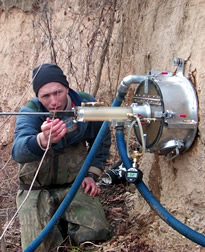This page has been archived and is being provided for reference purposes only. The page is no longer being updated, and therefore, links on the page may be invalid.
|
|
Device to Gauge Erodibility of Soil Can Aid Watershed PlannersBy Luis PonsJune 9, 2003 Watershed managers and structural engineers may benefit greatly from a soil-erodibility testing device developed by the Agricultural Research Service. The Jet Test Apparatus, developed by hydraulic engineer Gregory J. Hanson of the ARS Plant Science and Water Conservation Research Laboratory in Stillwater, Okla., applies stresses to soil beds by means of a water jet that can be pumped at various flow rates. It may become vital equipment during testing of aging, earthen flood-control structures such as dams and dikes, as well as in ARS efforts to understand, predict and control soil erosion and sedimentation within the nation's streams and lakes. The device already has been used in cooperative research of stream bank stability with the ARS Sedimentation Laboratory in Oxford, Miss. The apparatus allows users to measure resistance to erosion in cohesive soils by analyzing the portion of the soil bed scoured by the jet stream in relation to the hydraulic stress placed upon the surface. The water-jet test is simple, quick and relatively inexpensive, and can be used under field and laboratory conditions, according to Hanson. In addition, it produces coefficients that can be used in common equations fed into computer models to forecast future erosion. Hanson works in the Stillwater laboratory's Hydraulic Engineering Research Unit. ARS is the U.S. Department of Agriculture's chief scientific research agency. Originally, the jet-test device, patented in 1993, only differentiated soil materials in earthen auxiliary spillways on dams. But recent modifications also allow it to characterize streambed and stream bank materials. The new version is also smaller and faster than the original. The device can be set up at different angles, including vertical ones, and move soil ranging in consistency from fine sand to hard clays. It has worked in streambeds at depths up to three feet. It can also be used on soils away from waterways, if a water source is provided. |

